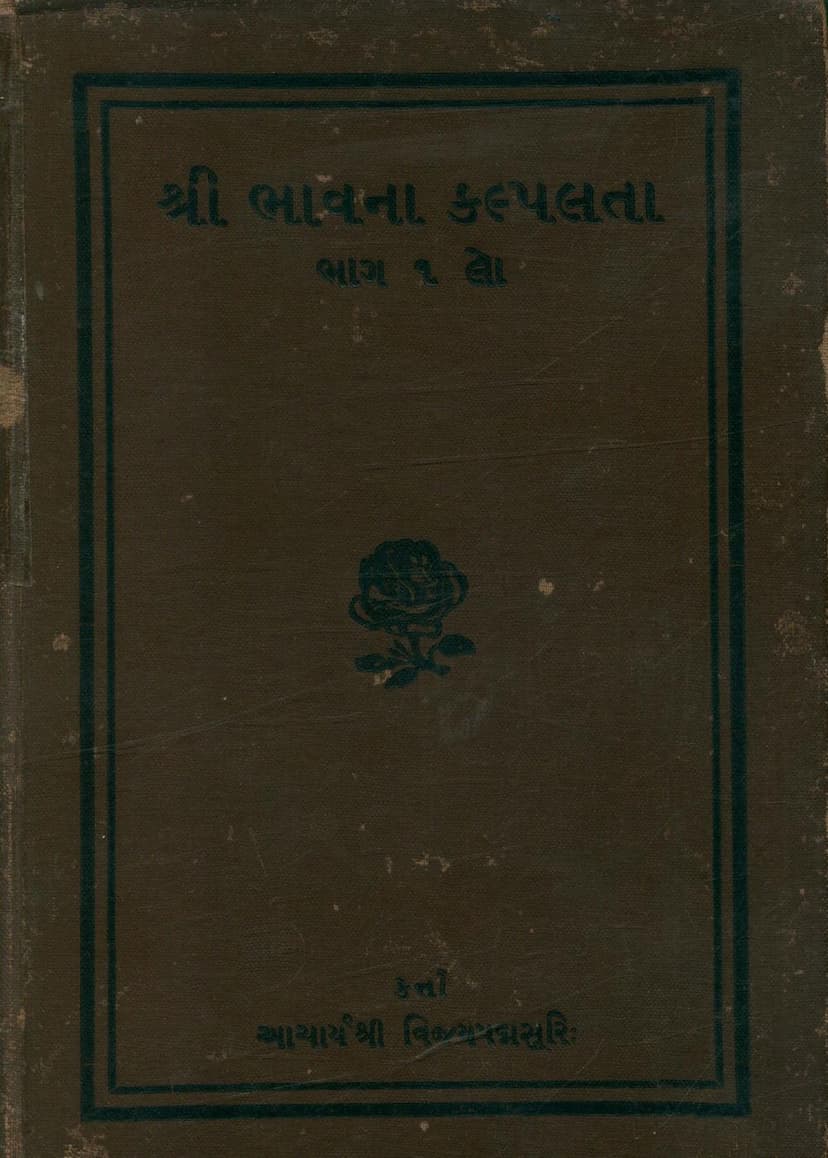Bhavna Kalpalata
Added to library: September 1, 2025

Summary
Here is a comprehensive summary of the Jain text "Bhavna Kalpalata" (Book 1), based on the provided content:
Book Title: Bhavna Kalpalata (Part 1 - Anitya Bhavna) Author: Acharya Shri Vijaynemisurishwar, compiled by Vinayanu Shri Vijaypadmasuri. Publisher: Shri Jain Granth Prakashak Sabha
Overall Purpose: The "Bhavna Kalpalata" is a guide to cultivating spiritual mindfulness (Bhavna) within the Jain tradition. This first part focuses specifically on "Anitya Bhavna," the contemplation of impermanence. The text aims to help individuals understand the transient nature of worldly existence and encourage them to pursue spiritual liberation.
Key Themes and Content:
-
The Nature of Existence (Anitya Bhavna):
- The text begins by describing the world and life as transient and full of suffering, likening it to a vast ocean with numerous troubles.
- It emphasizes the impermanence of the body, wealth, and relationships, urging readers not to attach themselves to these fleeting aspects of life.
- Numerous examples from Jain scriptures and history illustrate the downfall of powerful figures and the ultimate futility of worldly possessions and attachments.
-
The Rarity of Human Life and the Jain Path:
- The text highlights the immense difficulty and rarity of attaining a human birth, especially one with access to the Jain teachings.
- It emphasizes that the Jain philosophy is considered supreme among all philosophies due to its comprehensive and unbiased approach to reality.
- The importance of Syadvada (the doctrine of conditioned predication) and Anekantavada (the doctrine of manifold aspects) within Jainism is discussed, contrasting it with the one-sided views of other philosophies.
-
The Importance of Bhavna (Contemplation):
- The text places a strong emphasis on the practice of Bhavna (spiritual contemplation) as a means to purify the mind and attain spiritual progress.
- It likens Bhavna to essential elements like fire (for burning impurities), wind (for dispersing negativity), a lamp (for dispelling ignorance), and a cleansing agent.
- The text details various types of Bhavnas, including the Twelve Bhavnas (like Anitya, Asharan, Sansar, Ekattva, Shuchit, etc.) and the Four Bhavnas (Maitri, Pramod, Karunya, Madhyastha).
-
The Teachings of Great Souls:
- The text draws heavily on the teachings and examples of eminent Jain acharyas and historical figures, notably:
- Acharya Shri Hemchandrasuriji: His profound scholarship and influence are highlighted, along with his praise for Jain philosophy.
- Acharya Shri Vijaynemisurishwar: The primary inspiration and guiding figure behind this work, his spiritual achievements and vast contributions to Jainism are detailed.
- Acharya Shri Vijaypadmasuri: The compiler of this volume, his humility and dedication to making spiritual knowledge accessible are evident.
- Numerous stories and examples of great souls like Bharata Chakravarti, Elachi Kumar, Gajsukumar, Bhagvan Mahavir, Bhagvan Parshvanath, King Nala, Rohini, Shubhulam, and others are presented to illustrate the power of Bhavna, detachment, and adherence to Dharma.
- The text draws heavily on the teachings and examples of eminent Jain acharyas and historical figures, notably:
-
Ethical Conduct and Virtues:
- The text stresses the importance of ethical conduct, including non-violence, truthfulness, celibacy (Shil), contentment, and devotion to the Jinendra (the enlightened ones).
- It provides detailed narratives showcasing the steadfastness of individuals in upholding their vows, even in the face of severe trials and temptations.
-
The Value of Wealth and its Proper Use:
- While acknowledging that wealth can be a cause of downfall due to attachment, the text also emphasizes the importance of using wealth for righteous purposes (Dharmasthanaka).
- It highlights the meritorious act of building and renovating temples, donating scriptures, and supporting the Jain community.
- The examples of patrons like Vastupal-Tejpala, Seth Dalpatbhai, Seth Maneklal, etc., serve as models for righteous spending.
-
The Path to Liberation (Moksha):
- The ultimate goal presented is Moksha (liberation from the cycle of birth and death).
- The text consistently guides the reader towards detachment from worldly pleasures and the cultivation of inner virtues through the practice of Bhavna, adherence to the Three Jewels (Samyak Darshan, Samyak Gyan, Samyak Charitra), and the observance of vows.
Structure and Style:
- The text is written in Gujarati, employing a poetic and narrative style, primarily using verses (Chhand) and prose explanations.
- It follows a traditional structure, starting with invocations and salutations, followed by the core teachings and illustrative stories, and concluding with dedications.
- The detailed table of contents (Anukramanika) at the end of the provided excerpt lists the numerous topics and stories covered in the book, indicating its comprehensive scope.
In essence, "Bhavna Kalpalata" (Part 1) is a profound spiritual treatise that uses vivid examples and reasoned arguments to instill in the reader a deep understanding of impermanence and the transient nature of worldly life, thereby motivating them to dedicate their lives to the pursuit of spiritual enlightenment through the practice of virtuous conduct and mindful contemplation within the Jain framework.